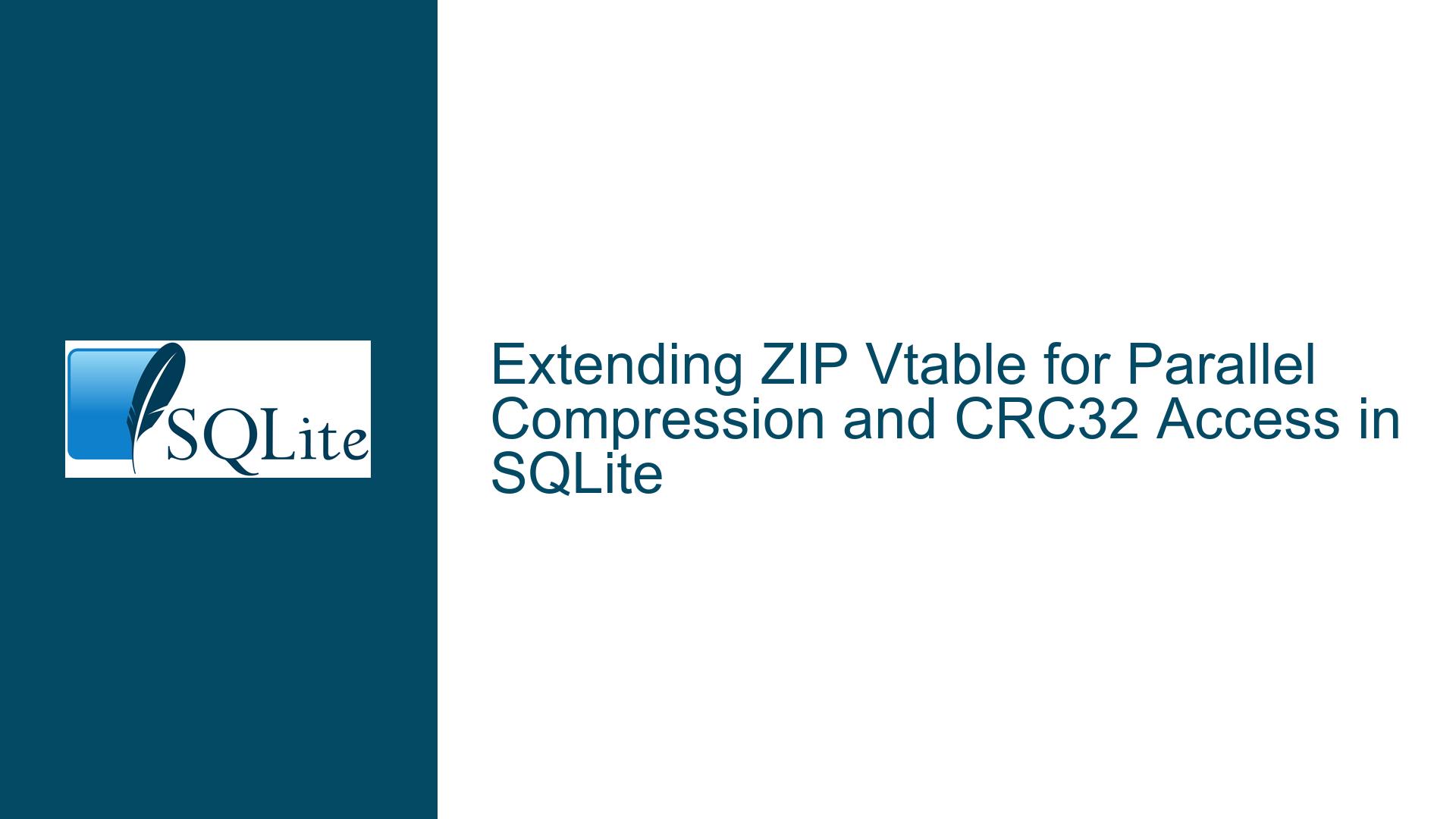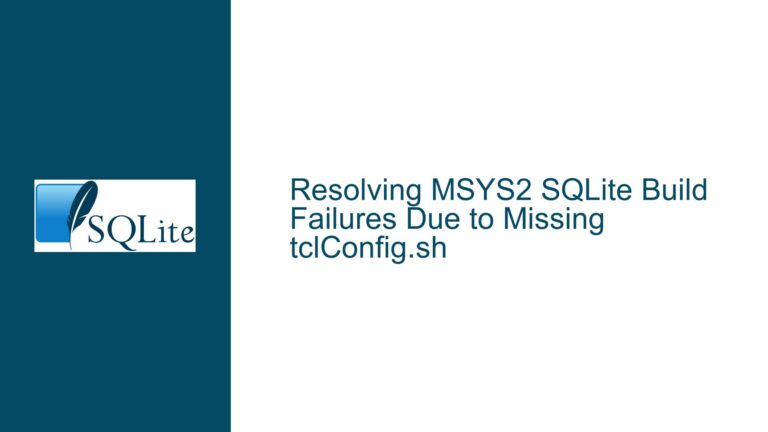Extending ZIP Vtable for Parallel Compression and CRC32 Access in SQLite
Issue Overview: Extending ZIP Vtable for Parallel Compression and CRC32 Access
The core issue revolves around optimizing the handling of large ZIP files within SQLite, specifically focusing on the ZIP virtual table (vtable) implementation. The current ZIP vtable, while functional, lacks certain features that are critical for efficient parallel processing of large ZIP files. The primary concerns are the absence of CRC32 access during decompression, the inability to write uncompressed size (sz) and raw data (rawdata) without null constraints, and the lack of a compressed size column (szz). Additionally, the performance overhead of calculating lengths of data and rawdata blobs is a concern, as it currently requires reading and allocating these values, which is inefficient for large datasets.
The ZIP vtable in SQLite is designed to interact with ZIP files as if they were database tables, allowing users to query and manipulate ZIP file contents using SQL. However, the current implementation has limitations that hinder its effectiveness in high-performance scenarios, particularly when dealing with large files and parallel processing. The vtable exposes a rawdata column for accessing uncompressed data during decompression but does not provide access to the CRC32 checksum, which is essential for data integrity verification. On the compression side, the vtable requires that both the uncompressed size (sz) and rawdata be set to NULL, which is not ideal for scenarios where these values need to be explicitly set.
Furthermore, the current implementation does not provide a direct way to access the compressed size of an entry, forcing users to rely on implicit calculations that can be computationally expensive. The lack of a CRC32 column and the inability to write sz and rawdata without null constraints are significant limitations that need to be addressed to enable efficient parallel processing of large ZIP files.
Possible Causes: Limitations in ZIP Vtable Implementation
The limitations in the current ZIP vtable implementation can be attributed to several factors. First, the vtable was likely designed with simplicity and general use cases in mind, rather than high-performance scenarios involving large files and parallel processing. As a result, certain features that are critical for optimizing performance, such as CRC32 access and compressed size columns, were not included in the initial implementation.
Second, the requirement for sz and rawdata to be NULL during compression suggests that the vtable was designed to handle compression in a specific way, potentially to simplify the internal logic or to ensure compatibility with certain use cases. However, this design choice limits the flexibility of the vtable, particularly in scenarios where users need to explicitly set these values.
Third, the absence of a direct way to access the compressed size of an entry is likely due to the fact that this information is not explicitly stored in the ZIP file format. Instead, the compressed size is typically calculated based on the length of the compressed data blob. While this approach works for most use cases, it can be inefficient for large files, as it requires reading and allocating the entire blob just to determine its length.
Finally, the lack of support for overriding the length() function for virtual columns is a limitation of the SQLite vtable API itself. The API does not provide a way to intercept calls to length() on virtual columns, which means that users cannot optimize the calculation of lengths for large blobs without reading and allocating the entire blob.
Troubleshooting Steps, Solutions & Fixes: Enhancing ZIP Vtable for Parallel Processing
To address the limitations of the current ZIP vtable implementation, several enhancements can be made to support parallel processing of large ZIP files. These enhancements include exposing the CRC32 checksum, adding a compressed size column, allowing sz and rawdata to be set without null constraints, and optimizing the calculation of lengths for large blobs.
1. Exposing CRC32 Checksum for Decompression:
The first step is to modify the ZIP vtable to expose the CRC32 checksum for each entry during decompression. This can be achieved by adding a new column to the vtable that stores the CRC32 value. The CRC32 checksum is typically stored in the ZIP file’s central directory, so the vtable will need to read this value and make it available to the user.
To implement this, the zipfile.c source file will need to be modified to include a new column in the vtable schema. The column should be named crc and should be of type INTEGER. During decompression, the vtable should read the CRC32 value from the ZIP file and populate this column with the appropriate value.
2. Adding a Compressed Size Column:
The next step is to add a compressed size column to the vtable. This column, which can be named szz, will store the size of the compressed data for each entry. The compressed size is typically stored in the ZIP file’s local file header, so the vtable will need to read this value and make it available to the user.
To implement this, the zipfile.c source file will need to be modified to include a new column in the vtable schema. The column should be named szz and should be of type INTEGER. During decompression, the vtable should read the compressed size from the ZIP file and populate this column with the appropriate value.
3. Allowing sz and rawdata to be Set Without Null Constraints:
The third step is to modify the vtable to allow sz and rawdata to be set without null constraints during compression. This will enable users to explicitly set these values, which is necessary for parallel processing scenarios.
To implement this, the zipfile.c source file will need to be modified to remove the null constraints on the sz and rawdata columns. The vtable should be updated to handle cases where these values are explicitly set by the user, rather than requiring them to be NULL.
4. Optimizing Length Calculation for Large Blobs:
The final step is to optimize the calculation of lengths for large blobs. This can be achieved by overriding the length() function for the vtable’s virtual columns. However, since the SQLite vtable API does not provide a direct way to intercept calls to length(), an alternative approach is needed.
One possible solution is to precompute the lengths of data and rawdata blobs and store them in separate columns. This way, the vtable can simply return the precomputed lengths when length() is called, without needing to read and allocate the entire blob. To implement this, the zipfile.c source file will need to be modified to include new columns for storing the lengths of data and rawdata. These columns should be named data_length and rawdata_length, respectively, and should be of type INTEGER.
5. Testing and Validation:
Once the above enhancements have been implemented, it is important to thoroughly test the modified vtable to ensure that it works as expected. This includes testing the new columns (crc, szz, data_length, and rawdata_length), as well as verifying that the vtable can handle large files and parallel processing scenarios.
Testing should include both unit tests and integration tests. Unit tests should focus on individual components of the vtable, such as the new columns and the modified compression logic. Integration tests should focus on the overall behavior of the vtable, including its ability to handle large files and parallel processing.
6. Contribution and Integration:
If the modifications are successful, the next step is to contribute the changes back to the SQLite project. This involves submitting a patch to the SQLite development team, along with a detailed explanation of the changes and their benefits. The patch should include the modified zipfile.c source file, as well as any additional files that are necessary for the changes to work.
The SQLite development team will review the patch and determine whether it should be incorporated into the official SQLite distribution. If the changes are accepted, they will be included in a future release of SQLite, making them available to all users.
Conclusion:
Enhancing the ZIP vtable in SQLite to support parallel processing of large ZIP files is a complex but achievable task. By exposing the CRC32 checksum, adding a compressed size column, allowing sz and rawdata to be set without null constraints, and optimizing the calculation of lengths for large blobs, the vtable can be made more efficient and flexible. These enhancements will enable users to handle large ZIP files more effectively, particularly in high-performance scenarios involving parallel processing.






